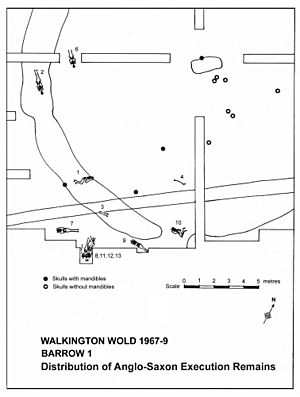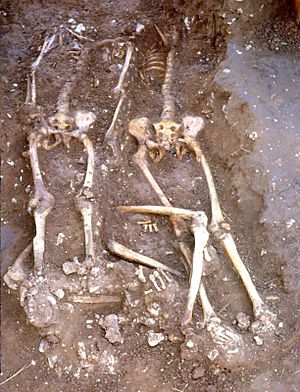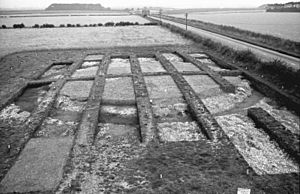Walkington Wold burials facts for kids
The Walkington Wold burials are a group of ancient skeletons found in the East Riding of Yorkshire, England. These bones belong to 13 people from the Anglo-Saxon period, which was a long time ago, between the 5th and 11th centuries. They were discovered in the late 1960s while people were digging up a much older Bronze Age burial mound, called a barrow.
After studying the bones, experts believe these Anglo-Saxon individuals were criminals who had their heads cut off as punishment. This site is special because it's the most northern place in England where this kind of burial has been found.
Discovering the Burials
In the late 1960s, two archaeologists, Rod Mackey and John Bartlett, were working near the village of Walkington. They were digging at a Bronze Age barrow (an old burial mound) when they found something unexpected. Between 1967 and 1969, they uncovered 12 skeletons. Ten of these skeletons were missing their skulls, but they also found eleven separate skulls. Most of these skulls were missing their jawbones.
The bodies were buried in a scattered way, not neatly in rows. Three of them seemed to be buried together. Most of the skulls were found quite far from their bodies. Some skulls were even in the middle of the old burial mound, while the bodies were around the edges. At first, people weren't sure who these people were. Some thought they might have been victims of a late Roman attack, or perhaps people killed as part of a Celtic head cult.
What We Learned Later
In 2007, archaeologists Jo Buckberry and Dawn Hadley took another look at the skeletons. They found out that there were actually 13 individuals, not 12. All of them were young adults, aged between 18 and 45. They also discovered that all the skeletons and skulls they could identify were male.
Using a special method called Radiocarbon dating (which tells us how old things are), they found that the burials happened over a long period, from the mid-600s to the early 1000s. They also realized that the three bodies that seemed to be buried together were actually buried at different times in the same spot.
By carefully examining the bones, the experts saw signs that these men had been officially put to death by having their heads cut off. It seems that some of them even needed more than one blow. It was common in Anglo-Saxon England for the heads of executed criminals to be put on poles. This was a warning to others. The burial site at Walkington Wold is on a small hill near an old road, which would have been a good place to display the heads. The fact that many skulls were missing their jawbones suggests that the jawbones fell off as the heads decayed while on display.
We don't know what crimes these men committed because there are no old records about them. The burial site is located between Walkington and an old, now-empty village called Hunsley. It's right on the edge of what used to be two different local areas, called "hundreds." Burying people on the border between communities, especially at an old burial mound, showed that these executed individuals were pushed out of society, even after they died. Rod Mackey, one of the original discoverers, said that the area was locally known as "'Hell's Gate.'" This suggests that people remembered it as a place where executions happened a long time ago.
Why This Site Is Important
The Walkington Wold site is special because it's the most northern example found so far of an Anglo-Saxon execution cemetery. It helps us understand that these places were used for a very long time, even before they were first written about in the 900s. It also shows that in the middle and later Anglo-Saxon times, men were more often executed for crimes than women. The site also proves that some practices continued even during big changes, like when the Vikings came and settled in England.
The Anglo-Saxons often reused old Bronze Age burial mounds for their own burials. These old mounds were sometimes thought to be places where spirits or creatures like dragons and goblins lived. By burying the executed criminals at Walkington Wold in such a place, they were made outcasts even in death, linked with these scary spirits because of their crimes and punishment.
Images for kids







